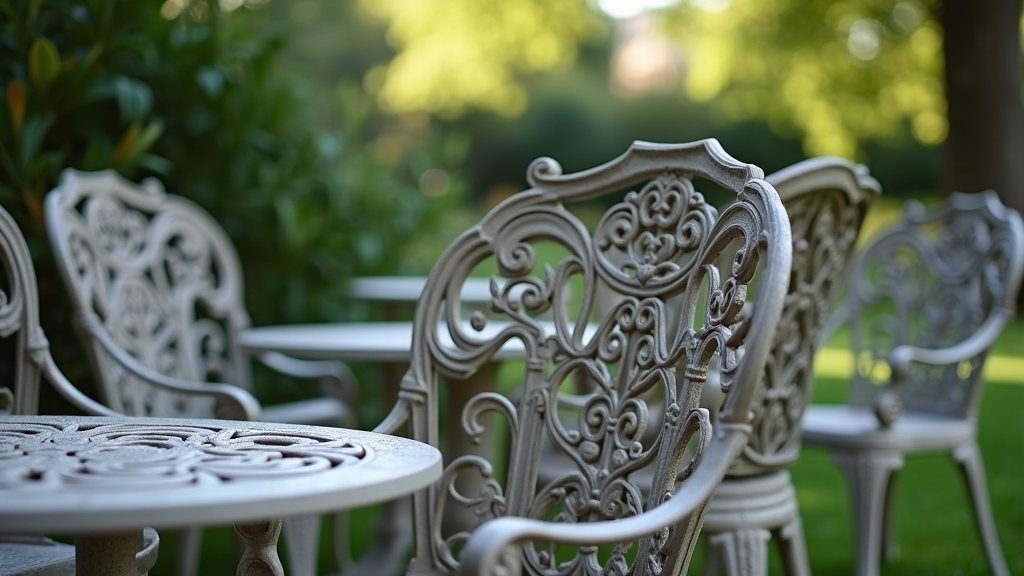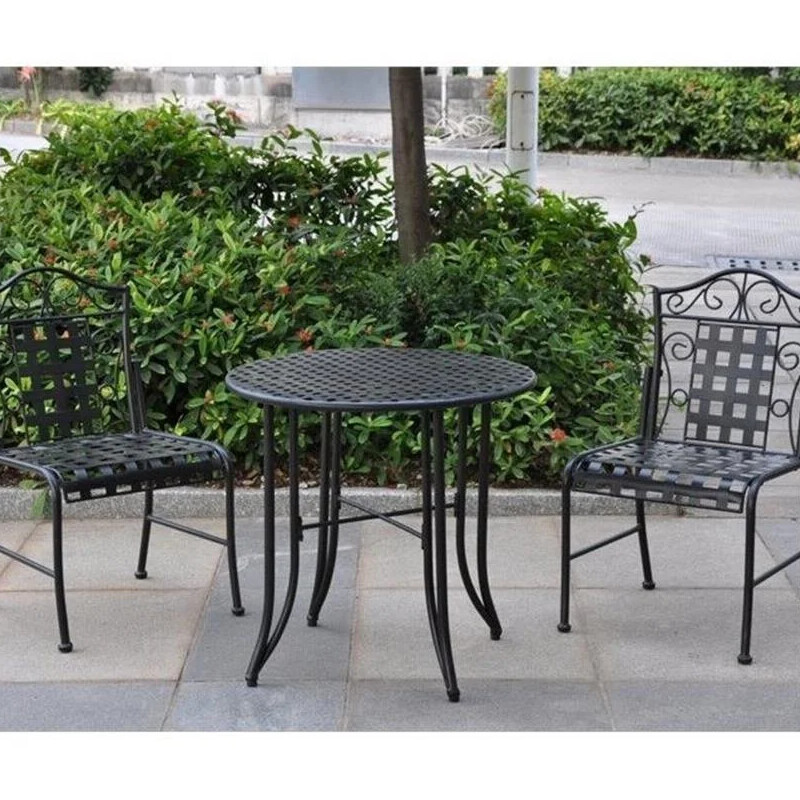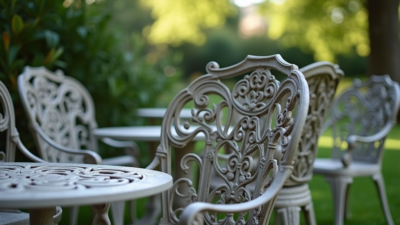When choosing outdoor furniture, the type of metal you select can have a big impact on durability, design, and upkeep. Two popular options are wrought iron and cast iron. Both have been used for ages in outdoor settings, though each comes with its own benefits and challenges.
This article explains the differences between wrought iron and cast iron outdoor furniture, offering you the essential details you need to decide which one fits your lifestyle and outdoor environment best.

The decision often comes down to factors such as weight, maintenance needs, and design style. Whether you appreciate the delicate detailing of wrought iron or the robust feel of cast iron, understanding these differences will help you make an informed choice for your patio, garden, or balcony.
Overview of Outdoor Furniture Materials
What is Wrought Iron?
Wrought iron is a type of iron that is shaped by hand or with simple tools. Known for its clean curves and artistic detailing, wrought iron carries a rustic yet elegant appeal. Furniture crafted from wrought iron often features intricate scrollwork and patterns that add character to outdoor spaces. Its more malleable nature allows designers to create eye-catching pieces that serve as both functional seating and artistic statements.
What is Cast Iron?
Cast iron, on the other hand, is produced by pouring molten iron into molds. The resulting pieces are sturdy and heavy, giving them a robust quality that many homeowners appreciate. Owing to the uniform structure produced during casting, cast iron resists impact damage and stands up well to regular use. It is commonly favored in traditional outdoor settings where durability is a high priority.
Understanding the differences in manufacturing processes helps explain why these metals perform differently in outdoor conditions.
Wrought iron is celebrated for its flexible design potential, while cast iron is chosen for its long-lasting strength.
Recommended Reading: 3-Piece Wrought Iron Outdoor Bistro Patio Sets
Pros and Cons of Wrought Iron Furniture
 Wrought iron outdoor furniture is admired for its blend of style and practical function. Here are some advantages and drawbacks:
Wrought iron outdoor furniture is admired for its blend of style and practical function. Here are some advantages and drawbacks:
Pros:
- Allows for intricate, customizable designs that add a unique touch
- Feels lighter and is easier to rearrange when updating your outdoor space
- Exudes a classic, elegant charm that fits many décor themes
Cons:
- Can rust if it isn’t properly cared for
- Often requires periodic painting or sealing to maintain its look
- Might not be as durable in extremely harsh weather conditions
The potential for artistic detail in wrought iron is a big draw, though it does mean that ongoing maintenance is very important.
Pros and Cons of Cast Iron Furniture
Cast iron outdoor furniture is valued for its stable, long-lasting characteristics. Consider these points when weighing your options:
Pros:
- Exceptionally strong and heavy, ensuring a stable setup
- Resilient against impacts and built to last for many years
- Carries a traditional, timeless look that suits classic designs
Cons:
- The heavy weight makes it challenging to move or rearrange
- Offers less flexibility in design compared to wrought iron
- Often comes with a higher price tag due to its manufacturing process
While cast iron’s rugged build is very important for long-term use, its inflexibility might limit your options if you like to update your outdoor area frequently.
Key Feature Comparisons
- Durability & Strength
Outdoor furniture has to withstand weather, temperature changes, and everyday use. Wrought iron, though durable, can be more prone to rust if not looked after regularly. Cast iron, with its robust structure, is built to resist impacts and generally lasts much longer.
Bottom line: If long-term toughness is what you need, cast iron is the better pick. This metal stands up remarkably well to sustained use.
- Maintenance & Aesthetics
Maintaining your outdoor set should be easy and cost-effective. Wrought iron typically calls for routine sealing or painting to prevent deterioration, helping preserve its artistic look over time. Cast iron, while more resilient overall, demands less frequent attention but might not offer as much design flexibility.
Bottom line: Choose wrought iron if artistic detail and design variety are key, but opt for cast iron if you prefer a less fussy maintenance routine. - Weight & Mobility
The ease with which you can move your furniture is essential, especially if you like rearranging your outdoor setting. Wrought iron, being lighter, is generally more convenient for repositioning or seasonal changes. Cast iron, however, offers superior stability due to its weight, even though that same heaviness can make rearrangements a real task.
Bottom line: If mobility and frequent updates are important, wrought iron is a smart choice; if you value sturdiness above all, cast iron wins out.
User Reviews & Overall Reputation
Feedback from those who have invested in these outdoor furniture types reveals distinct opinions. Many users applaud wrought iron for its custom, timeless appeal and the ability to fit a variety of design themes. Regular upkeep remains a common topic, as owners note that caring for wrought iron is crucial to keeping it looking its best.
In contrast, cast iron receives praise for its heavy-duty structure and enduring performance. Homeowners enjoy its steadfast nature and often choose it for settings where stability is paramount. Despite its weight and less flexible design, many appreciate that cast iron remains a very important long-lasting option for outdoor enjoyment.
Final Verdict: Which One Should You Choose?
Your choice between wrought iron and cast iron outdoor furniture ultimately hinges on your lifestyle, aesthetic preferences, and how much effort you want to put into maintenance.
If you lean toward designs that offer a personalized, artistic feel and enjoy the freedom to rearrange your space at will, wrought iron might be your best bet. Its lighter weight and elaborate detailing can set a stunning tone for your outdoor living area, though be prepared for a fair amount of upkeep to keep rust at bay.
On the other hand, if you need furniture that stands the test of time and can handle heavy use with minimal fuss, cast iron is a solid option. Its durable build provides extraordinary strength, making it ideal for those who favor stability over frequent changes. While moving cast iron pieces can be demanding, many users find that its robustness more than justifies the initial effort and cost.
Either option can step up your outdoor environment when paired with thoughtful design and proper care. The right choice will depend on whether you prioritize flexible aesthetics or unmoving reliability. Take a moment to consider your daily habits and what will serve you best in the long run.
When it comes down to it, outdoor furniture is all about matching practical needs with your personal style. Both wrought iron and cast iron have their own unique strengths, so choose the one that truly reflects your vision for a comfortable and attractive outdoor space.
